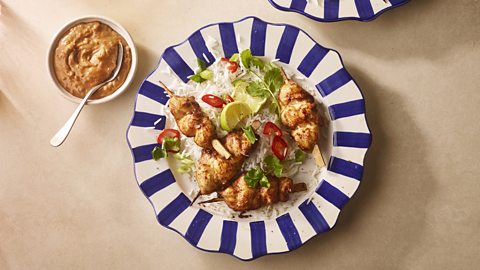How autism can affect your relationship with food
Neurodivergence can have a range of influences on our diet – but why, and is there any support that can help?
By Becca Bull

Feeling overwhelmed by the thought of eating around others or finding the smell and texture of common foods disgusting are common experiences for autistic people. It’s easy to see, then, how this neurodivergence can have a powerful influence on diet.
It’s estimated that one in 100 people in the UK are autistic – although the number may be much higher, potentially double this figure. And of the children on the autistic spectrum, 70% have distinctive eating behaviours, like accepting very few foods.
“Primarily, this restrictive eating pattern could mean sticking to certain food groups,” says Dr Elizabeth Shea, a clinical psychologist who works with autistic people with eating difficulties.
“Commonly, that might be things like your beige carbohydrates – foods that look very similar, have a similar texture and are often really easy from a sensory point of view.
“For some people, their restrictive eating becomes significant. They might lose a lot of weight, or they may have a nutritional deficiency because they’re not eating a wide range of foods.”
Disordered eating and autism
According to the National Autistic Society, autistic people may also be more likely to experience eating disorders, with some research suggesting between 4% and 23% of people with an eating disorder are autistic.
Avoidant and Restrictive Food Intake Disorder (ARFID) is one eating disorder that’s commonly linked to autism.
ARFID’s frequently portrayed as when someone has an incredibly limited palate, but eating disorder charity BEAT points out there are various elements to it. It says:
ARFID might look quite different in one person compared to another. Because of this, ARFID is sometimes described as an ‘umbrella’ term – it includes a range of different types of difficulty.
Nevertheless, all people who develop ARFID share the central feature of the presence of avoidance or restriction of food intake in terms of overall amount, range of foods eaten, or both.
Unlike some other types of disordered eating, ARFID is not linked to feelings about body weight or shape, the NHS stipulates.
You can find out more about ARFID with the BBC Bitesize guide: How can I help my autistic child eat new foods and be healthy?
Sensory differences
Imagine you’re having a great time eating out at a restaurant. Notice what you picture. Perhaps you’re in a vibrant setting with the sounds of chatter and clinking glasses, smells of different foods wafting through the air and a table filled with dishes that your excited group of friends or family are eating.
Many neurotypical people would find this an enjoyable environment while, for some autistic people, this setting would be actively upsetting or overwhelming.
The same could be said for children eating in a school canteen. Rob, now 30, used to have a restricted diet and explains being autistic made eating at school challenging. He was desperate to eat alone.
“Watching people eat made me want to throw up,” he explains, and would often return home at the end of the school day having eaten nothing.
On BBC Morning Live, Christine McGuinness talked about how autism has impacted her diet
Thankfully, with more autistic celebrities sharing their own experiences, there is a growing understanding.
Wildlife TV presenter Chris Packham is another famous face who’s open about his dietary needs.
He avoids eating anything sticky, like fruit, as the sensation of it on his hands is too unpleasant to overcome. “It’s just not worth the sensory discomfort,” he says.
“I don’t like touching food. I have to wash my hands afterwards if I do. So, I use cutlery to eat everything.
“I also use food as a control thing. I will, because I can, regulate what I eat. Particularly if I’m stressed.”
Anxiety around mealtimes
Mealtime anxiety can be linked to routines and rituals like always sitting in the same chair, or being specific about how food is arranged on the plate, explains Shea.
When we’re anxious we may try to create order in the world to make us feel better. “It’s almost like a phobia. It’s not just being awkward or stubborn.”
This also explains why some autistic people stick to the same foods and even brands.
“The more anxious you get, the more your sensory processing goes out of whack and you may find that you’re even more sensitive than you normally are to a smell, noise or taste.”
Sensing hunger
It’s not just external factors that have an impact on an autistic person’s eating, though.
“There’s a sense called interoception, which refers to feelings inside your body,” says Shea. “We know from research that autistic and neurodivergent people struggle with this.
“That means they may not always know when they’re hungry, which could lead to them not eating for significant periods of time. That [can] be quite risky.”
Digestive problems
There’s also a link between autism and digestive issues, with data analysis suggesting children with autism were four times more likely to experience them than those without autism. The most common are constipation, diarrhoea and stomach pain – all issues that are bound to help shape a person’s relationship with food and eating.
“Is it diet causing these issues, or is it part of being autistic? We’re still not sure,” says Shea.
Some experts have suggested there could be benefits to following gluten-free and casein-free diets, and cite anecdotal evidence from parents.
Research outcomes are very mixed, though.
Bahee Van de Bor, a registered dietitian and spokesperson for the British Dietetic Association, explains: “A 2016 systematic review of randomised controlled trials [with 214 autistic participants] found a gluten-free and casein-free diet didn’t lead to any notable changes in gastrointestinal symptoms.”
In any case, diets that prohibit certain food groups or core ingredients are to always be approached with caution, and the National Institute for Health and Care Excellence (NICE) says that exclusion diets (such as a gluten-free diet) and supplements shouldn’t be used to manage the core characteristics of autism.
How to help make eating easier
So, what can you do to help an autistic person who is finding eating challenging?
Rob’s mum Anna took a “no pressure” approach to help her son become the adventurous eater he is today, but it took years. She said: “Sometimes he’d just play with, handle or kiss the food but not eat it.”
Rob adds that learning to cook was a big help and he agrees with his mother that, for him, disguising food was “the worst thing you could do” because it would lead to a loss of trust.
Shea says she helps support her patients by:
- Understanding each person’s individual experience of autism and their sensory differences.
- Allowing them the food they like, even if it’s unhealthy, to avoid causing more anxiety.
- Using techniques like deep breathing to lower anxiety.
- Following a regular eating schedule to help the body understand the feelings of hunger and fullness.
- Gradually exposing them to particular textures or tastes. For example, by sitting next to someone eating food they find difficult, looking at it in a shop, or chopping it up, but not eating it.
If you are concerned about the issues raised in this article, help and support is available for both autism and disordered eating.
Originally published March 2025
Want more? Visit BBC Food on Instagram, Facebook and Pinterest or watch the latest Food TV programmes on BBC iPlayer.



